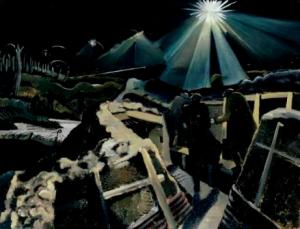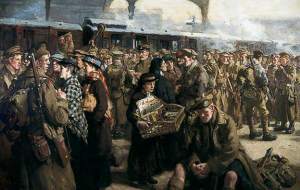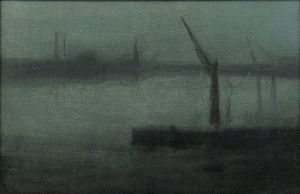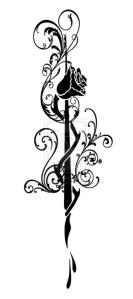“I put in painters, or started to, because I learn as much from painters about how to write as from writers. You ask how this is done? It would take another day of explaining. I should think what one learns from composers and from the study of harmony and counterpoint would be obvious.”
When interviewing Ernest Hemingway for The Paris Review, George Plimpton acknowledged the “occasional waspish tone of the answers”, born of the author’s belief that writing “is a private, lonely occupation with no need for witnesses until the final work is done.” This sounds all too familiar. I’ve overdone my own exposure, in essays that – while useful at the time of writing my first novel, for relearning techniques – have left me somewhat strung out when it comes to starting anything new. I’m perhaps too self-aware now for a clear sense of originality. When Hemingway stated that “such ideas should remain unexpressed”, with probing questions leaving him “almost inarticulate”, I know what he means, with the usefulness of hindsight. That being said, the essays were good to write, in the way taking a clock apart allows you to know its mechanism for when something goes wrong.
But on one subject, Hemingway was willing to show his hand: those artistic influences found in the deftness of a painter with tubes and brushes, the composer his sheet music. Donne to Cezanne, “the good Kipling” to Van Gogh, Bach to Mozart – all creators that touched his life and his mind, to be called upon when he would “stand in absolute concentration” for writing. Nowadays, with the help of mobile technology, we can as easily wander through the minds of favourite artists via apps and websites like Pinterest, as we can take the conventional route of walking the echo-halls of an art gallery. Playlists can be tailored to a written draft. Dance and drama can evoke the method approach, for getting into the mind and moods of a character.
“Harmony” in music, is defined as “the simultaneous combination of tones, especially when blended into chords pleasing to the ear”, while counterpoint is “the art of combining melodies / the texture resulting from the combining of individual melodic lines.” Generally speaking, harmony and counterpoint are the agreement of elements distinct from one another, and “any element that is juxtaposed and contrasted with another”. Those moments are wonderful – aren’t they? – when you touch upon a particular paragraph that fits the background music of a bar or pub, at a time of day when you’re drinking something with the taste to somehow mirror the mood. When it feels as though everything has been geared towards inspiring an image or mood. As a method-writer, I work towards achieving this kind of interdependency of art to form a “backdrop” – something sustainable for the duration of a scene, perhaps. Watching Weimar cinema to add disquiet (in filters of blue, with nuances of light and shadow) or wandering into a particular gallery room to find the narrative of a display. When a piece of instrumental music seems to have been written for a character or scene, adding textures previously unthought of, there’s the chance to review your writing from a different angle, one governed more by instinct and mood than lyrical content.
Any piece of art can at once stand alone, and be linked to another in a different format/medium. There might be no apparent crossover, except in subjective terms. Time changes perspective too, with personal experiences adding emotional layers almost indefinable, except for the way they get under your skin and stay there. Godspeed You! Black Emperor’s Dead Flag Blues once belonged to a winter’s morning slog uphill, until I read the opening chapter of Stephen King’s The Gunslinger for the first time. Now the heavy-tread rhythm and bronze guitar twangs belong to Roland’s feet through the desert, on the trail of the man in black.)
When choosing décor, we look for the blends of tone and texture that will make a house feel like a home; furnishing the lines of a living space to present an image of ourselves. Even the sparsity of an office can be made to feel like an extension of “home”, with those framed works and prints by a favourite artist, drawings made by the kids, holiday souvenirs, newspaper cuttings, empty whisky miniatures lined up in a row. Each facet reflective of individuality, while shining together to create the image as a whole. It’s amazing what you can learn about a person, based on what they choose to surround themselves with – or allow others to surround them with.
Remembering and learning about WWI, we can read the words of Sassoon, Rosenberg and Owen to live in the immediacy of those desperate moments. They connect with the likes of Paul Nash and Richard Jack, whose work asserts direct historical links as well as the more subconscious achievements of art to carry emotional resonance forward in time.

Paul Nash, “The Ypres Salient at Night”

Richard Jack, “The Return to the Front: Victoria Railway station”
As much to make sense of what they were experiencing, as to capture the rawness of conflict for the ones who would rebuild peace, the artists imposed control – a strange sense of beauty – upon the ugly chaos around them. Time has no way of diminishing their effect. Standing in front of Jack’s Return to the Front: Victoria Railway station in York art gallery, I couldn’t move for about twenty minutes, absorbing each detail. The scene is absorbing in its raw portrayal of human emotions, played out in the set of a jaw, the resigned curve of shoulders, downcast eyes, pity around the girl’s mouth, the looming presence of the waiting train. It was a world away from my own liberal time… and still, almost one hundred years ago. Art crosses the borders of time and geography, carrying emotional salience forward to our own time and circumstances. Somehow, the unimaginable becomes all too real.
And it’s still going on.
“On a trip like this it is best to do rapid fire sketches, with movement. I used my drawing book like a camera. I rely very much on the power and energy of the initial drawing.”
But why is art necessary in a war?
Graeme Lothian, who was sent on the same trip as Jules George, has a unique perspective. Decades ago he was a commando before breaking his back. He sees the artists’ purpose as complementary to the journalists and historians who will also chronicle the war.
“It’s good to stand there and take a step back and just look at the Army from a distance. This will be history one day, Camp Bastion will be dust. We are painting history.”
And he believes the very act of deploying artists to Afghanistan shows progressive thinking on the part of the MoD.
“The Army have always said no to artists, now they are changing their mind. There is a sea change that artists are important.” –
Why do we need oil painters in a war zone?
There are some works of art which must be experienced in their original state for the message to come across. A postcard rendition of a Mark Rothko piece has no chance of capturing the awesome (I mean this in the strongest senses), silent sentience, hung on a wall in the Tate gallery. When surrounded by them in the Rothko room, you are compelled to fall silent yourself; to stand still, and watch them breathe. Pulse with life. They draw you in, as though towards an answer for every posed question, or perhaps the end of time itself.
I can’t bring myself to look at some of them full-on, only with the sideways glance of a reluctant admirer, with defiance and submission both. The damn things speak for themselves. They make you listen.
Art allows us to learn as much about ourselves as each other. While inadvertent plagiarism (cryptomnesia) is an undeniable part of creativity, there’s no sense in shutting down a project for the tension between goodwill and guilt, and certainly no shame in reworking ideas as an homage to another. As Pete Seeger put it, “You hear an old song you like but you’d like to change a little, there’s no crime in changing a little… It’s a process. It’s not any particular song, it’s not any particular singer. It’s a process by which ordinary people take over old songs and make them their own.”
(I wish I’d known about this as a teenager, when I gave up on writing out of fear I was just borrowing from all the inspirational childhood literature. Personal perceptions are what make us unique. Everyone has their own story to tell.)
I feel most at home among the Tonalist painters, who in the late 19th to early 20th centuries, established an American art movement based on “an abiding spiritual feeling for the intimacies of the human landscape.” The name itself alludes to “the use of muted natural tones… portraying the symbolic and abstract character of landscape forms.” James Abbott McNeill Whistler, a key founder, sought to bring harmony to the wilderness of nature with the essence of humanity. Like Hemingway, Whistler valued the idea of artistic crossovers.
“Nature contains the elements, in colour and form, of all pictures, as the keyboard contains the notes of all music. But the artist is born to pick, and choose, and group with science, these elements, that the result may be beautiful — as the musician gathers his notes, and forms his chords, until he bring forth from chaos glorious harmony.” – “Mr Whistler’s Ten O’Clock”, Public lecture, Prince’s Hall, Piccadilly, 20 February 1885.
The founder of abstract art, Wassily Kandinsky, “wanted to evoke sound through sight and create the painterly equivalent of a symphony that would stimulate not just the eyes but the ears”; he spoke of art in the synaesthetic language that is a characteristic blending of the senses. “Colour is the keyboard. The eye is the hammer. The soul is the piano with its many strings.” In the same way as Whistler, who believed that “art should not serve narrative, but rather project the artist’s subjective feelings through the handling of the medium,” and who drew upon the philosophy of “art for art’s sake,” Kandinsky wanted to further the internal appreciation of music through the colours he experienced; giving non-synaesthetes the chance to experience a sensory crossover too. But anything more would be a distraction from the audience’s emotional connection. A simple gratification was to be found in viewing art, without looking for any more meaning than what was before them.
As a chromesthete, I see colours and patterns in sound – predominantly music – and moods. Though abstract and impressionist art lend themselves towards some kind of external view of what goes on in my head, nothing comes quite so close as Whistler’s “Nocturne” set. The play between light and shadow, abstract over concrete, with things appearing not quite as they should seem. The once-firm lines of steel and stone are now seemingly spun from cobweb, and likely to be blown away in a wandering night breeze. Time is dialled down to sequential movements; less a narrative, than a handful of slow-shutter shots. The gluey state of dreams and drowsiness and half-light.

Nocturne, Blue and Silver – Battersea Reach
A construct undone, and somehow more accessible for it.
“Taking a cue from a critic who had referred to his early portrait of his mistress… as a ‘symphony in white,’ Whistler began to envision and entitle his works with the abstract language of music, calling them symphonies, compositions, harmonies, nocturnes, arrangements, and so forth.” It’s not difficult to see how the French critic would have drawn comparisons; just as snow is never only one colour, “The White Girl” (or “Symphony in White No.1”) is composed of as many shades in a pale palette as you would find instruments in an orchestral piece. In Whistler’s tonalist work, the visual theme weaves itself into the very semantics of music: “Nocturne” is defined as “a composition inspired by, or evocative of, the night” – that resonance found in the twilight hues of a trickling character piece for the piano, played to a blue-and-silver garden or lowlit bar. Disbelief is more easily suspended when written between the lines. Whenever I’m feeling not quite myself – stuck with my head on the writer’s block, greyed-out by the Everyday – I go flicking through the works of Whistler and his contemporaries, to find the same fluid surreality of a moonlight sonata. It’s a bit of immersion, prior to writing.
As individuals bring their experiences to art for subjective interpretation, so the arts in turn allow creators to reflect upon and complement each other’s work. What is the first draft of writing, but a slew of words spilt with inspiration? We then edit to needs, as a gardener prunes a rose to allow it to flourish. The painter somehow knows when the next dab of colour will be as a jarring note in a composition. It’s not so much the willpower to begin, as the control to Stop – to insist and argue with the inner critic, that a piece is complete.







